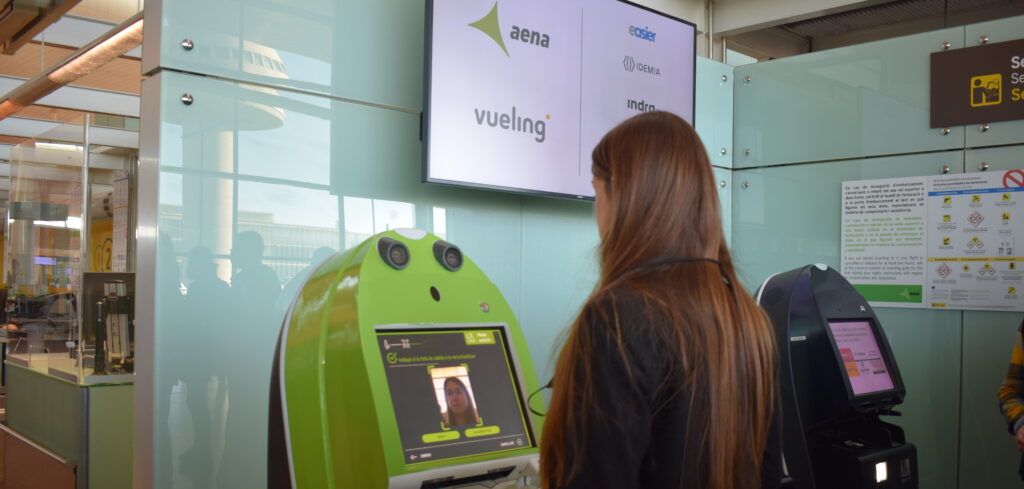Airport operations company Aena has launched a facial recognition pilot program for contactless boarding at Josep Tarradellas Barcelona-El Prat Airport in Spain, which includes a self-bag-drop feature.
The solution has been designed to integrate all the passenger verification steps into one, enabling travelers to pass through the airport without having to show any identification. To access the plane with their face, the passenger must fill in a form on the ‘facial recognition’ section of the Aena app. (Registration can also be done physically in two kiosks opposite gate B35 and in the Vueling self-check-in area at the airport.) Participating passengers will have exclusive access at security checkpoints and the boarding gate on the Barcelona-Malaga route. They will also have the option to leave their suitcases at the self bag drop by using facial recognition.
The biometric devices are based on identification technology that recognizes people’s physical and non-transferable characteristics. They have been installed across the airport – in the self-check-in area and at the security checkpoint and boarding gate. At this final check, passengers’ biometric data, facial features and documentation (Spanish national identity card or passport) will be validated. Mobbeel provided the mobile application that enables travelers to register their biometrics and verify their identity. This is done when passengers scan their national identity cards or passports with near-field communication (NFC) and supply a proof-of-life selfie to ensure they are who they say they are.
This launch forms part of Aena’s partnership with the airline Vueling and the technology companies Easier, Idemia, Indra, Materna IPS and Mobbeel. The collaborative project between Vueling and Aena began in 2021 with the airline’s passengers on the Barcelona-Malaga route.
During this project, Indra was responsible for the platform that is used to integrate the various systems and devices that make up the solution. This platform enables the collection of identifying and biometric data at the enrolment and CUSS kiosks, security checkpoint and boarding gate. This is then processed and integrated with Aena’s systems to ensure the proper operation of the solution as a whole.
The biometric self-bag-drop system was designed by Materna IPS. It takes an image of the passenger and checks it in real time against the database of those enrolled in the biometric program. This is used to confirm if the passenger is in the program and, if so, to let them check in their luggage by themselves on the spot.
Passenger self-service solution provider Easier integrated the biometric devices and associated middleware for passenger enrolment and verification at each control point. To do this, the company supplied dual units (common-use self-service kiosk and biometric registration on the same device) and electronic doors with a passenger uniqueness detection system, to operate from the time passengers enter the security zone until they board.
Idemia provided facial image capture in the enrolment kiosks, the airside access electronic door and the electronic boarding gate – meaning passengers will be identified using Idemia’s biometric engine
Amparo Brea, Aena’s chief growth officer and director of innovation, sustainability and customer experience, said, “This project, part of Aena’s strategic innovation plan, is the last step in a series of actions led by the company since early 2019 aimed at testing the use of biometric systems at different points in the airport. We are convinced that this technology will significantly improve the passenger experience at our airports, and these projects allow us to speed up its deployment. We provide passengers with tools that allow them to pre-empt part of the documentation checks currently carried out at the airport, so they can move through it more securely, smoothly and comfortably.”
According to Calum Laming, Vueling’s chief customer officer, “Being able to offer such a comprehensive biometric experience confirms our desire to improve our customers’ experience at the airport. It also makes for a much more streamlined and modern customer flow. This is a highly technological project, a key element in Vueling Transform and in our digitalization strategy to improve our service and give customers more autonomy and flexibility in managing their travel experience.”


